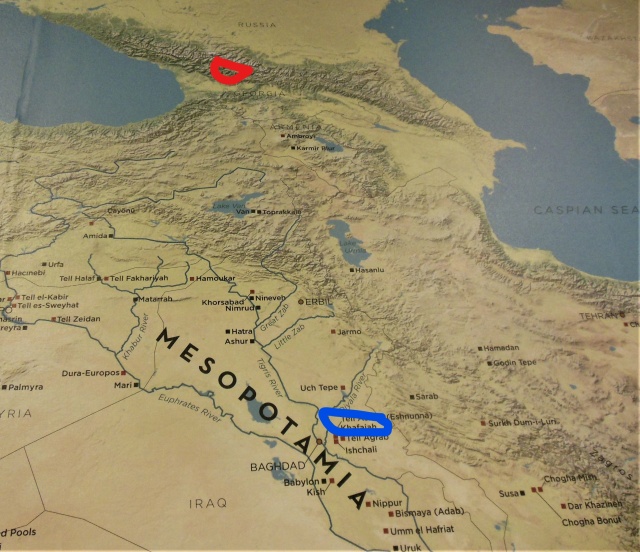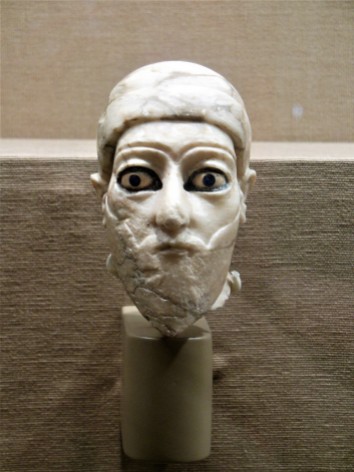If I were to pick anywhere in the world to hide Sumerian art in plain sight, I would choose Svaneti. Svaneti, the Republic of Georgia’s mountainous northwest region, is so remote that it was often used as a kind of safe house for art during times of conflict.

Road through UshguliThe main road in Svaneti’s upper region looks like this, though much of the year it is covered in snow and inaccessible (until 1935 the residents got around on sleds and the wheel was non-existent).
Back in 2016, after two flights, an overnight train, and a terrifying minibus ride, HOB and I arrived in Lenjeri—near the town of Mestia in Svaneti. We were there for the music, a sort of polyphonic chant in the Svan language. The music was sublime, though as we were to discover, the art was equally captivating.

Lenjeri, near our guest house
After walking to Mestia from our guest house accompanied by pathetically bony cows, we located Mestia’s museum. OMG OMG OMG THIS MUSEUM GAH!!!!!!!!!!!!!!! [calming down, taking a deep breath] Mestia’s museum is an art history treasure trove. I mean, everything in that museum is amazing but when we got to the icon room I turned to HOB and said “So why do these icons look Sumerian?”
Sumerian icons? Hear me out.
No, on second thought, just have a look first.
The icons are all from 12th – 13th century Svaneti, painted with tempera on wood.
The Sumerian statues are from the collection of the Oriental Institute in Chicago, created anywhere from 2700 – 2000 BC out of alabaster.
So yeah, they look alike, but they’re made 4000 years apart in different parts of the world. But maybe not so far apart after all? Let’s go to a map:

Map from the Mesopotamian room at the Oriental Institute in Chicago
The blue squiggle is where the Sumerian statues were made and the red squiggle is Svaneti.

Display in the Mesopotamian room in the Oriental Institute
Here’s another map showing the migration of people out Mesopotamia into several areas, including the Caucuses.
Now I have some proof that people migrated out of Sumeria into Georgia. What else?

Church of St. George, Nakipari, Svaneti
Well, HOB and I had seen plenty of evidence of Svaneti’s ties with pagan culture. For example, this church in Nakipari, we stopped to see on the way to Ushguli. The animal heads decorating the church front are pagan, not Christian.
It was my old friend Google that turned up several connections between Svan and Sumerian culture. Not going to lie: when I discovered that the Svan sun god Lile is believed to have evolved from the Sumerian god Enlil, I gave myself an art history nerd high five.
The Svan people, who once worshipped the sun god Lile, still sing 4000 year old songs in his honor. Listen to this Svan folk song addressed to Lile and see if your hair doesn’t stand up with the wonder of it.
I have not managed to find any direct connection between Svan and Sumerian visual art. But I am convinced beyond a doubt that there is one. The people of Svaneti have been hiding their art treasures for centuries. If we return one day and a friendly Svan unlocks a church and shows us a secret closet behind an icon painting where they are hiding a Sumerian statue, I wouldn’t be the least bit surprised.

How we got to Kashveti: overnight train from Tbilisi to Zugdidi followed by a marshrutka ride from Zugdidi to Mestia. Lenjeri is about a 45 minutes walk from Mestia. From Mestia to Ushguli we shared a jeep with other travelers
Where we slept: Guest House Folk Music. Price: €42 for a double (including meals). Recommended: highly.











How in blazes did you research this!
LikeLiked by 1 person
Quite fortunate to have primary sources close at hand—the Oriental Institute of Chicago has one of the world’s best collections of Sumerian art.
LikeLike
Amazing.
LikeLiked by 1 person
I’m glad you agree. I went down a rabbit hole on youtube listening to ancient Svan songs. The second one I saw was sung, in part, by the man whose family we stayed with in Lenjeri!
LikeLike
Wow really? That’s pretty cool.
LikeLiked by 1 person
This is so interesting, I love connections like this. We are all much more closely than it first seems (or some would like us to think) – great piece 🙂
LikeLiked by 1 person
Thanks so much! I am a taxonomer at heart and I’m constantly sorting out connections between things in my head. It almost feels like a religious practice, if that makes any sense.
LikeLiked by 1 person
It does make sense! For me it is the connections in story-telling, the common themes that bind us and how surprisingly similar tales appear in apparently unconnected places
LikeLiked by 1 person
You know, this is a terrific article. In case nobody has told you this, let me be the first.
Neil S.
LikeLiked by 1 person
Thanks for your kind words Neil. These are two terrific art forms so writing about them is a pleasure.
LikeLiked by 1 person
That’s a very interesting and plausible argument. I liked the animal heads on the church. I hope that’s not your Svan song. Is the language modern?
LikeLiked by 1 person
Perhaps this could be a great subject for a master’s thesis for someone more academically inclined than myself.
Appreciate you throwing a pun in there. Next to medieval art, puns are my great love.
The Svan language is ancient and I think there are only like 30,000 or less speakers left. Since it is unwritten that means it is highly endangered. Fortunately the Svans are quite savvy and invested in teaching the culture to the younger generation.
LikeLiked by 1 person
Very cool. They had better super guard that stuff.
LikeLiked by 1 person
I’m not certain how well it is guarded. The teenaged daughter of the family we stayed with had a key to a church that was closed to the public and she let us in to see the 11th century frescos! Perhaps the remoteness is what guards it.
LikeLiked by 1 person
*Spock eyebrow* Fascinating! I also had to look up the Wikipedia article for the Svan language.
LikeLiked by 1 person
Spock eyebrow, LOL! Oh man, the Svan culture is so fascinating; the music, the dancing, the architecture—everything!
LikeLike
THE ICONS OF SVANETI ARE SVNETIAN. FOR SURE YOU CAN NOT PROVE THAT I AM WRONG BUT I CAN PROVE THAT YOU ARE WRONG.
Firstly, I am Native Svan. Ivane is my name and the last name is Pirveli. Prirveli in Georgian means the First. Now little bit of linguistic journey:
How is the first in different languages? :
1. Georgian: Pirveli
2. Italian: Prima
3. Spanish Primera
4. Bulgarian: първи (PRVI)
5. Azerbaijani and Turkish – BIRinci. They like B not P would have been Pirinci.
6. Russian – PERVI
7. English FIRst funnily enough would have been heard as a PIRst, somewhere in the past.
8. Greek, – Πρώτα.
Rest of the translations you can look.
Secondly I am native Svani language speaker as well and I agree with you that there are many similarities between Swans and Sumers but what about other old nations- like QALDEvians? BTW in Svaneti we have village by the name of Qalde (Q is pronounced differently, Non-Swan Georgians do not experience that word. Therefore claiming about icons they are Summerian is not so good idea.
and Thirdly, open to discuss and deep-dive
LikeLiked by 1 person
Hello Mr. Pirveli, I congratulate you on being from one of the most beautiful places in the world (with the most glorious music!). Thank you for the linguistic lesson. If you visit the US, I don’t recommend using the Russian version of your name since Pirveli sounds much nicer than Pervi here.
I hope the next generation of young people are still learning and speaking Svan and that there is growing scholarship on the origins of the art, language and music. I am no scholar, though I maintain the resemblance between Svan and Sumerian art is strong. What do you think are the historical influences on Svan painting?
LikeLike
Hello, The Wife of Bath. I will take into consideration your advice, anyway I was not going to use Russian version.
Thanks for your still positive feedback on my emotional previous post.
What I know from Museum folks in Svaneti, Svanetian paintings (ფრესკა) are distinguished from typical Georgian paintings. The latter had an influence from Byzantium or Greek school. The main difference is that Svans were painting Saints with full of life on their faces, even little bit overweight :). Love of Life and being a Hero (St.George) are the main lines of the Svani School. Unfortunately I am not a painter and into the art to give some more details. But recently I had my new linguistic discovery: Pirveli in Albanian Language is Ipare. 🙂 This is the name of the village where Pirvelis live and where you shoot the picture of Animal Sculptures at the Church!
P.S. Thanks for the Article.
LikeLiked by 1 person
My favorite ფრესკა were in the Archangel church in Kashveti—what a beautiful church and we so lucky to have a chance to go inside!
LikeLike